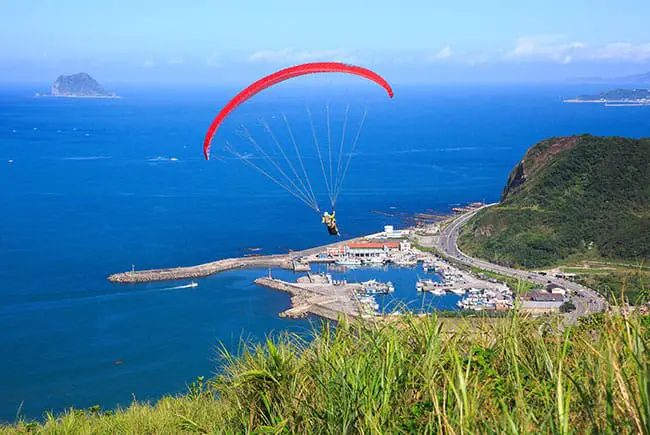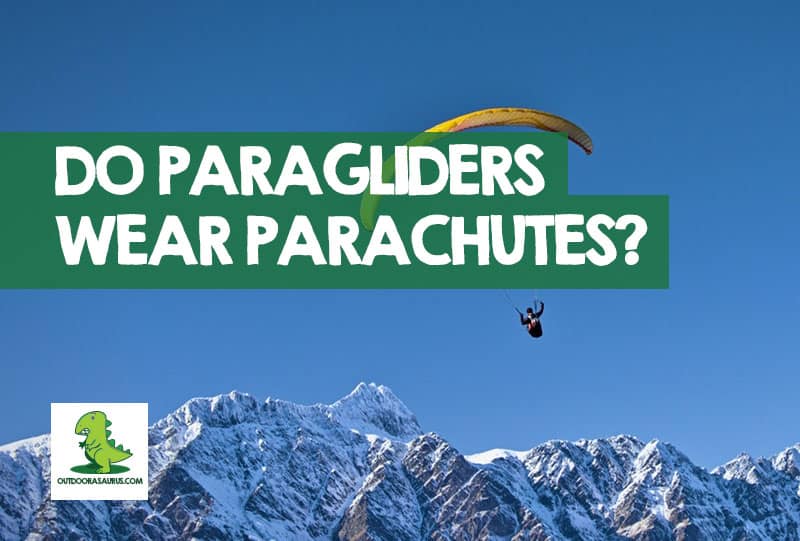If you’re new to paragliding, safety has to be one of the main concerns, and understandably, you’re going to have a lot of questions before you take a lesson. One of the more commonly asked questions is about parachutes and whether they are needed.
Do paragliders wear parachutes? Yes, they do. Most paragliding harnesses will have reserve parachute connected to it or, to maximize safety whilst paragliding.

What’s the best reserve parachute for paragliding?
Selecting the best type of parachute for you is critical for maximizing your safety while paragliding.
Most professional paraglider pilots will wear a parachute. In fact, most serious paragliders will wear a parachute to maximize safety and gain peace of mind.
One of the most commonly used types of paragliding parachutes are Pulled-Down Apex parachutes. This type of chute is sufficient for most people, but it is important to understand all differences between all of the main types of paragliding parachutes.
Did you know? Paragliding can cause motion sickness, but there are ways in which you can combat it. Read my tips on how to avoid feeling ill once you are in the air.
Below, I will go through the main types of paragliding parachutes, and I will break them down to ensure that you choose the best type of paragliding parachute to keep you safe and relaxed during your next flight.
Plus, I will answer some of the major questions regarding paragliding parachutes.
Is a reserve parachute needed for paragliding?
Yes, and here are some reasons for buying a paragliding parachute.
- Collision risks: The sky is rarely empty. If you collide with a drone, big bird or another flyer, then you would be way safer if you have a reserve parachute.
- Weather risks: The weather can change for the worst quickly. If you get stuck in uncontrollable turbulence, then a reserve chute is vital for your safety. Plus, with a reserve parachute, your anxiety is drastically lowered if you face turbulence. Therefore, you can concentrate better while paragliding.
- Gear failures: You trust your life to several different parts and pieces when on a flight. Any or all of them could break due to age, stress, or manufacturer’s error. A reserve parachute is necessary even if a single riser, karabiner, or maillon breaks or fails to work properly.
- Pilot error: If you suddenly discover you are in an unrecoverable flying incident due to a stupid mistake on your part, then a reserve parachute is crucial.
Types of paragliding reserve parachutes
You probably believe one type of reserve parachute is as good as another. That is not true. Though today’s parachutes have design variances, every type works the same way.
Nevertheless, they are not all made the same. From what I have seen, the quality of construction, design, and efficiency may differ greatly.
I suggest staying with trusted name-brands with proven track records. Selecting the correct type of parachute for you from the list below should be done cautiously.
Pulled-down apex (PDA)
The pulled-down apex provides a modest design which will work if it is large enough to provide a decent descent. It is the ‘old-style,’ that is known to be reliable in the paraglider industry.
Plus, it is the least expensive type of reserve parachute. Carefully study the chute’s size. It is measured by area in m². It is a key factor that determines a reserve chute’s sink rate, which is measured per square meter.
Square-round
The Companion SQR includes some of the best features of the PDA and Cruciform styles. It has PDA characteristics mixed with additional innovative design characteristics that provide a top-notch approach in the non-steerable category.
Because of the stepped skirt of this type of chute and the way it is packed, the chute opens relatively quickly. The air can escape better through the channels, which aids in providing more pendular steadiness.
However, it is not made for paragliding. This lessens the chance of a mirror-effect in comparison to Rogallos or the square-shaped chutes.
Certification tests reveal what reserves do with no paraglider attached to a pilot. The design team utilized their experience and real-life experimentation to improve the behavior so that it deploys reliably in many different situations.
It consistently resists the interference of the paraglider with minimal impact on the sink rate. Overall, it allows for a minimal amount of effort on the pilot.
Rogallo
After throwing a non-steerable reserve chute and considering the countless horrors underneath them, many times pilots purchase Rogallo parachutes. Numerous acro and test pilots trust them.
Also, if you go up high enough, then you can control the main chute. Therefore, it is possible to control your landing.
Rogallo parachutes provide a high rate of descent since they have an aerofoil. Plus, they are the speediest to open and provide more options for landing since you can steer them.
All reserve chutes have a chance of down-planing if the paraglider is not disabled. A few Rogallo types are more likely to down-plane because they tend to glide.
Cruciform (square)
This intermediate priced square chute has vents on the corners of it. These vents help keep the rate of descent the same (proven in a certification test).
Also, it has a package that is more compact. The pendular is quite stable and there is more lift generated if you track it sideways. However, it does not provide any directional control.
The glide that results from this type of chute may be beneficial at times. If you are unprepared for launch, it will not operate any better than a PDA. A PDA drops you onto whatever may be under your position.
However, if you are attempting SIV/acro overtop a landing target that is safe, then it is necessary to have a bigger area to land on. This is because you can not rationally estimate the area that you need to track underneath a reserve that is square.
Plus, you track further if you become disconnected from the paraglider. The Independence Ultra Cross is the most lightweight square chute. It is a relatively inexpensive model.
Ram-Air
A cut-away structure created for acro specialists. The main glider is released through deployment. It is used to pull a standard steerable parachute out, so you have total freedom in reaching a landing area that is safe.
How many people die from paragliding each year?
Around 1 out of every 10,000 Americans die in a car accident each year. Paragliding is much more popular than in Germany than in the United States and about 3 out of 33,000 German pilots die per year paragliding.
That is simplified to 1 out of 11,000 German pilots. That rate is slightly lower than the driving fatality rate in America. The driving fatality rate would be much higher in reality if you only counted the people who actually drive rather than the entire population.
On the flip side, statistics tend to show that paragliding is safer than activities like motorcycling or even horseback riding on average.
How safe is paragliding compared to hang-gliding
One of the best safety comparisons you can make will be paragliding versus hang-gliding (as a lot of people believe them to be very similar).
I published some research into the various safety statistics which give you real data on what’s the safest of the two sports.
To find out more, read this guide to which is safer.
Personal view: I believe paragliding to be very safe providing you have the right training. In fact, there are even examples of pregnant women continuing to enjoy the sport right up until they give birth.
Conclusion
Professional paragliders and anyone who is serious about paragliding while not pilot go on a flight without a reserve parachute. They allow the pilot to gain peace of mind knowing his or her safety is maximized.
The weather could become bad very quickly and you may want to make an emergency landing. Also, you could run into a big bird, drone, or another pilot.
Gear can fail and everyone makes mistakes so it is best to choose a parachute that makes the most sense for you.
Statistics show that paragliding is safer than motorcycle riding and you can stay extra safe by using a parachute.

